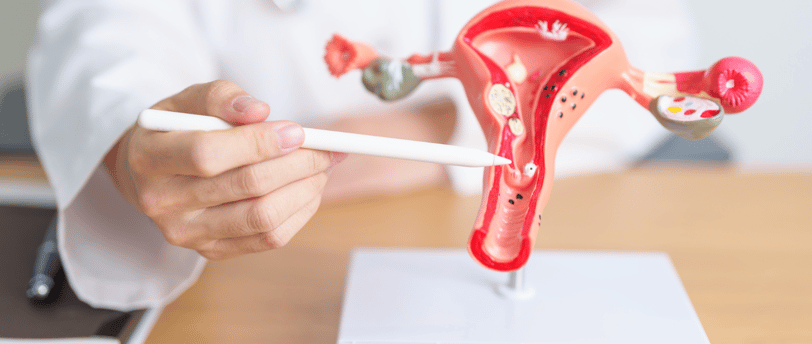When to See a Doctor: Recognizing Serious Fibroid Symptoms
Uterine fibroids are common non-cancerous tumors that can develop in or around the uterus. While many women experience mild or no symptoms, others may face severe pain, heavy bleeding, or fertility challenges. Knowing when to seek medical attention is crucial for preventing complications and ensuring proper treatment. This article outlines serious symptoms that require a doctor’s visit, as well as available treatment options.
GYNECOLOGIC ISSUES
3/18/20253 min read


1. Heavy or Prolonged Menstrual Bleeding
When It’s a Concern
Soaking through one or more pads or tampons every hour for several hours.
Periods lasting longer than seven days.
Passing large blood clots (larger than a quarter).
Feeling dizzy, weak, or fatigued, which could indicate anemia.
Why It’s Important:
Heavy bleeding can lead to iron deficiency anemia, causing extreme fatigue and weakness.
May indicate submucosal fibroids, which grow inside the uterine cavity and disrupt the endometrial lining.
2. Severe Pelvic Pain or Pressure
When It’s a Concern
Chronic, dull pelvic pain that does not go away.
Sharp, stabbing pain that occurs suddenly.
Lower back pain that worsens over time.
Why It’s Important:
Large fibroids can press on nearby organs, causing pelvic pressure and discomfort.
Sudden, severe pain could indicate fibroid degeneration, where a fibroid outgrows its blood supply and starts breaking down.
3. Frequent Urination or Difficulty Emptying the Bladder
When It’s a Concern
Needing to urinate often (even at night).
Feeling the urge to urinate but passing only a small amount.
Difficulty fully emptying the bladder.
Why It’s Important:
Fibroids located near the bladder can compress the urinary tract, leading to urinary issues or infections.
Severe cases may cause kidney damage if the urine flow is blocked.
4. Bloating or Constipation
When It’s a Concern
Persistent bloating or a feeling of fullness in the abdomen.
Difficulty passing stool or experiencing constipation that lasts for days.
Hemorrhoids or pain during bowel movements.
Why It’s Important:
Fibroids near the rectum can press on the intestines, causing bowel issues.
Severe constipation may lead to digestive complications if untreated.
5. Pain During Intercourse (Dyspareunia)
When It’s a Concern
Deep, persistent pain during or after intercourse.
Pain that worsens over time.
Why It’s Important:
Fibroids located in the cervix or near the vaginal wall can cause discomfort or pain during intercourse.
This can also lead to emotional distress and relationship difficulties if left unaddressed.
6. Difficulty Getting Pregnant or Recurrent Miscarriages
When It’s a Concern
Trying to conceive for over a year without success.
Multiple miscarriages without a known cause.
Why It’s Important:
Fibroids in certain locations, such as inside the uterine cavity (submucosal fibroids), can interfere with implantation and pregnancy.
Removing fibroids in select cases has been shown to improve pregnancy rates.
7. Sudden, Severe Abdominal Pain
When It’s a Concern
Intense, sharp pain that does not subside.
Nausea, fever, or vomiting accompanying abdominal pain.
Swelling or tenderness in the lower abdomen.
Why It’s Important:
Could indicate fibroid torsion, where a fibroid on a stalk (pedunculated fibroid) twists, cutting off its blood supply.
This is a medical emergency requiring immediate treatment.
8. Rapidly Growing Fibroids or Enlarged Abdomen
When It’s a Concern
Noticeable increase in abdominal size (similar to pregnancy).
Sudden growth of fibroids over a short period.
Why It’s Important:
While fibroids grow slowly, rapid growth may require further testing to rule out other conditions.
Fibroids larger than 10 cm may require surgical intervention.
When to Seek Emergency Care
Go to the doctor or emergency room if you experience:
Severe, sudden pelvic pain.
Uncontrolled heavy bleeding.
Signs of anemia (extreme fatigue, dizziness, pale skin).
Severe constipation with abdominal swelling.
What to Expect at the Doctor’s Office
A doctor may perform:
Pelvic exam to check for enlarged uterus.
Ultrasound or MRI to assess fibroid size and location.
Blood tests to check for anemia or hormonal imbalances.
Treatment Options
Treatment depends on severity of symptoms and future pregnancy plans:
Medications – Hormonal treatments (e.g., GnRH antagonists like Relugolix) to shrink fibroids.
Minimally invasive procedures – Uterine artery embolization (UAE) or MRI-guided focused ultrasound (FUS).
Surgery – Myomectomy for women wanting to conceive; hysterectomy for severe cases.
Conclusion
Uterine fibroids do not always require treatment, but serious symptoms should never be ignored. If you experience persistent pain, excessive bleeding, or fertility issues, consult a doctor for proper evaluation and treatment options.
References
Micić, J., Macura, M., Andjić, M., Ivanović, K., Dotlić, J., Micić, D. D., Arsenijević, V., Stojnić, J., Bila, J., Babić, S., Šljivančanin, U., Mostić Stanišić, D., & Dokić, M. (2024). Currently Available Treatment Modalities for Uterine Fibroids. Medicina, 60(868). DOI:10.3390/medicina60060868.
Krzyżanowski, J., Paszkowski, T., Woźniak, S. (2023). The role of nutrition in pathogenesis of uterine fibroids. Nutrients, 15(23), 4984. DOI:10.3390/nu15234984.
Wang, Y., Zhang, S., Li, C., Li, B., & Ouyang, L. (2020). Minimally invasive surgery for uterine fibroids. Ginekologia Polska, 91(3), 149-157. DOI:10.5603/GP.a2020.0034.
Donnez, J., & Dolmans, M. M. (2021). GnRH antagonists with or without add-back therapy: A new alternative in the management of endometriosis? International Journal of Molecular Sciences, 22(21), 11342. DOI:10.3390/ijms222111342.
Memon, S. I., Acharya, N. S., & Potdar, J. (2022). Spontaneous Expulsion of a Huge Cervical Fibroid After Uterine Artery Embolization Done as a Lifesaving Procedure for Acute Severe Abnormal Uterine Bleeding. Cureus, 14(10), e30163. DOI:10.7759/cureus.30163.
